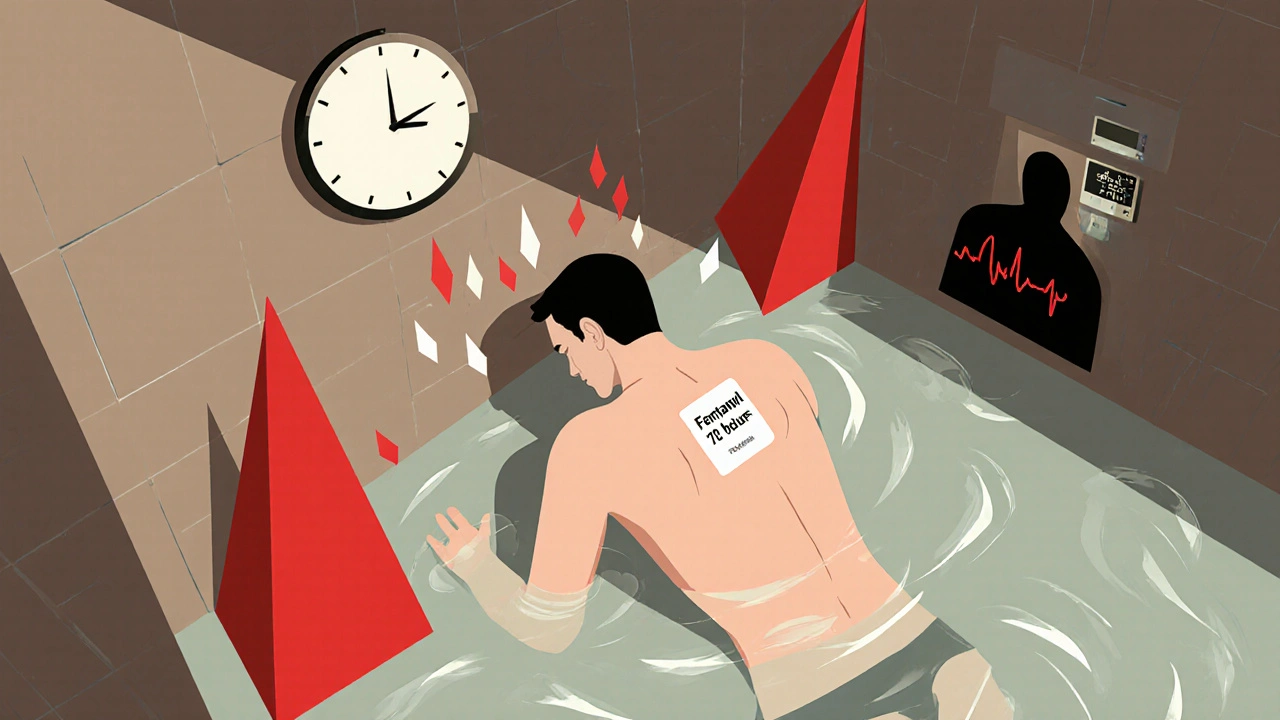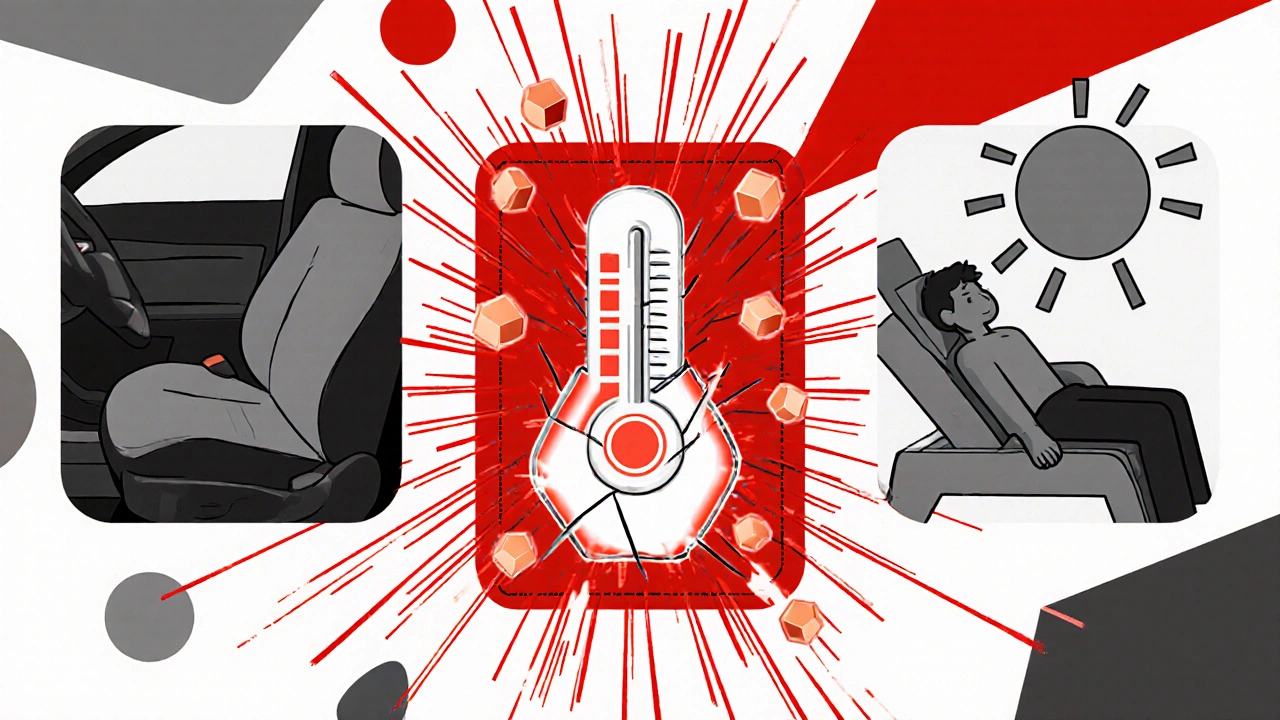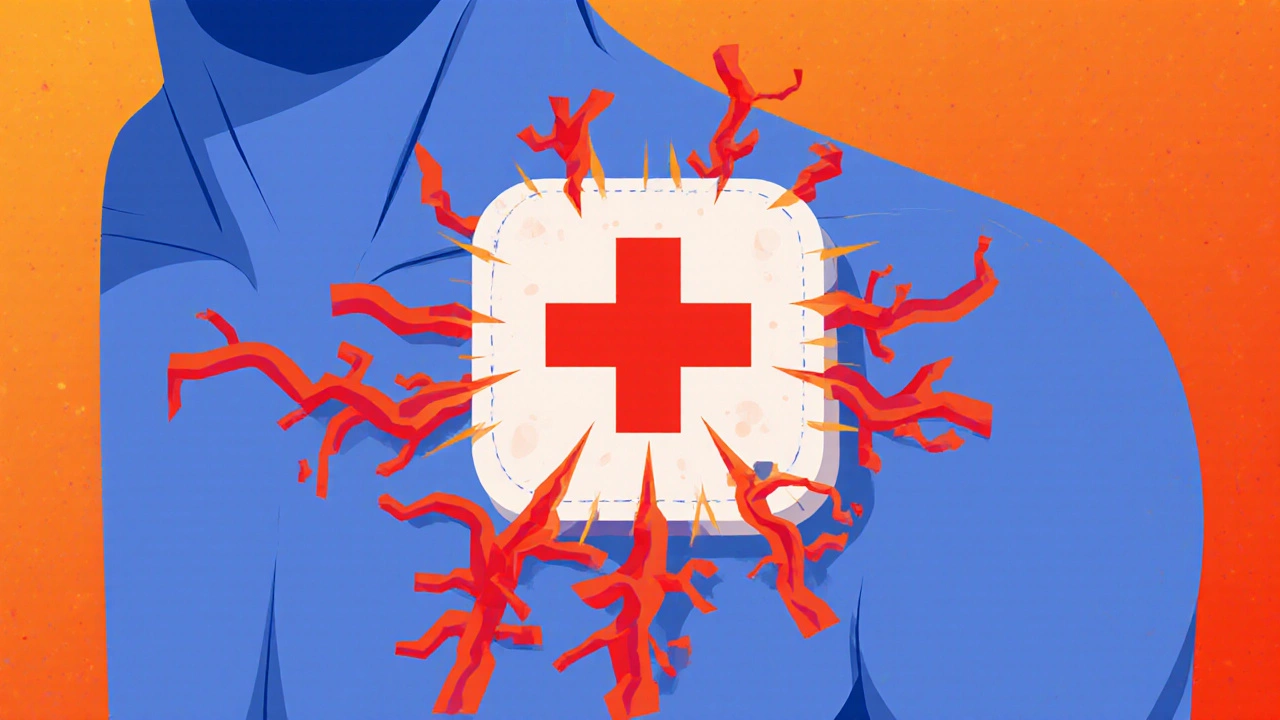Fentanyl Patch Heat Exposure Risk Calculator
Calculate Your Risk
Risk Assessment Results
Estimated Fentanyl Absorption Increase:
Specific Recommendations:
Important Safety Information
WARNING: This calculator estimates risk based on published research. Actual absorption varies by individual. If you have any symptoms of overdose, call 911 immediately.
Never: Heat the patch area, use heating devices, take long hot showers, or exercise vigorously while wearing a fentanyl patch.
Always: Remove patch after 72 hours and store away from children.
Using a fentanyl patch for chronic pain might seem simple-stick it on, wait, and the pain fades. But if you take a hot shower, use a heating pad, or even get a fever, you could be putting your life at risk. Fentanyl patches aren’t like other pain meds. They’re designed to release a steady, controlled dose over three days. But heat changes everything. It doesn’t just speed things up-it can push the drug into your bloodstream fast enough to stop your breathing.
How Fentanyl Patches Work (And Why Heat Breaks the System)
Fentanyl patches, like Duragesic, are made to slowly release the drug through your skin. The patch contains a gel with a set amount of fentanyl-usually 25, 50, or even 100 micrograms per hour. That’s enough to manage severe, long-term pain in people who already take opioids regularly. But the system isn’t magic. It relies on your skin’s natural barrier to control how fast the drug enters your blood.
When heat hits the patch, that barrier breaks down. Blood vessels near the skin widen. Skin becomes more porous. The gel inside the patch heats up and releases fentanyl faster. Studies show that if your skin temperature hits 40°C (104°F), fentanyl levels in your blood can jump by 33%. In one controlled experiment, adding a heating pad over the patch tripled the amount of fentanyl absorbed in just four hours. That’s not a small bump. That’s the difference between pain relief and a life-threatening overdose.
Real Cases, Real Consequences
This isn’t theoretical. There are documented deaths.
One patient wore a fentanyl patch and used a heating pad for back pain. Within hours, they stopped breathing and died. Another was undergoing surgery and placed under a warming blanket-standard procedure. But the patch kept releasing fentanyl as the blanket heated their skin. They slipped into respiratory failure and didn’t wake up.
Even exercise can be dangerous. One man with cancer was walking more than usual-trying to stay active. His body temperature rose. His patch released more fentanyl. He collapsed from opioid overdose. These aren’t rare mistakes. They’re predictable outcomes of ignoring basic safety rules.
What Counts as Heat? (It’s More Than You Think)
Most people know not to use a heating pad. But heat doesn’t just come from devices.
- Hot showers or baths-staying under hot water for more than 10 minutes raises skin temperature enough to affect absorption.
- Saunas and steam rooms-even brief exposure can spike fentanyl levels.
- Sunbathing or tanning lamps-UV rays heat your skin, even if you don’t feel hot.
- Heated car seats or blankets-these can sit right under the patch if worn on the back or hip.
- Fever-a body temperature over 38°C (100.4°F) can trigger faster absorption. If you get sick, call your doctor before assuming it’s just a cold.
- Strenuous activity-lifting heavy things, mowing the lawn, or even walking briskly in hot weather can raise your core temperature enough to be risky.
And here’s the part no one talks about: the patch keeps releasing fentanyl even after you take it off. For hours, sometimes up to a day, your body is still absorbing the leftover drug. So if you remove the patch and then jump into a hot tub, you’re still in danger.

Who Should Never Use These Patches
Fentanyl patches are not for everyone. They are strictly contraindicated for people who have never taken opioids before. A single patch can kill someone without tolerance. That’s why they’re never prescribed for post-surgery pain or short-term injuries.
They’re also risky for older adults, people with breathing problems like COPD, or those with liver or kidney issues. These conditions slow how your body clears fentanyl, making overdose more likely-even without heat.
And if you’re taking other medications like ketoconazole, erythromycin, or certain antidepressants, you’re at higher risk. These drugs block the enzymes that break down fentanyl, letting it build up in your blood. Add heat on top of that? It’s a recipe for disaster.
What You Must Do to Stay Safe
If you or someone you care for uses fentanyl patches, these steps aren’t optional-they’re life-saving.
- Never use heat sources. No heating pads, electric blankets, saunas, hot tubs, or tanning beds.
- Avoid long hot showers. Keep showers under 10 minutes and use warm-not hot-water.
- Watch your body temperature. If you have a fever, call your doctor. Don’t wait. Don’t assume it’s "just a cold."
- Limit physical activity. Avoid heavy lifting, intense workouts, or prolonged walking in hot weather.
- Check your patch placement. Don’t put the patch where clothing or bedding might press against it and trap heat (like under a waistband or on a heated car seat).
- Remove the patch exactly after 72 hours. Don’t leave it on longer. Don’t cut it or fold it. Don’t reuse it.
- Store patches safely. Keep them out of reach of children. Even a used patch still has enough fentanyl to kill a child.
Many people don’t realize that their doctor’s instructions are based on real deaths. This isn’t a suggestion-it’s a warning written in blood.

Signs You’re Overdosing (Act Fast)
Overdose from fentanyl patches doesn’t always look like someone collapsing. It starts quietly.
- Slowed or shallow breathing
- Extreme drowsiness-you can’t stay awake
- Confusion or dizziness
- Cold, clammy skin
- Blue lips or fingernails
- Unresponsiveness
If you see any of these, call 911 immediately. Give naloxone if you have it. Fentanyl overdoses often require multiple doses of naloxone because the drug is so strong. Don’t wait. Don’t hope it passes. Every minute counts.
What About Alternatives?
If you’re worried about heat risks, talk to your doctor about other options. There are extended-release pills, liquid opioids, or non-opioid treatments like nerve blocks, physical therapy, or certain antidepressants that help with chronic pain. Some newer patches are being tested to resist heat, but none are widely available yet.
For now, if you’re on a fentanyl patch, you have to treat it like a loaded gun. Heat is the trigger. And once it goes off, there’s no undo button.
Can a fever cause a fentanyl patch overdose?
Yes. Even a mild fever can increase fentanyl absorption by raising skin temperature and blood flow. While fever alone hasn’t been directly linked to overdose in published reports, it significantly increases risk. If you develop a fever while using a fentanyl patch, contact your doctor immediately. Do not wait for symptoms to appear.
Is it safe to use a fentanyl patch if I’m taking antibiotics?
Some antibiotics, like erythromycin and clarithromycin, can interfere with how your body breaks down fentanyl. This can cause the drug to build up to dangerous levels. Always tell your doctor and pharmacist about every medication you’re taking-including over-the-counter drugs and supplements. Never start a new drug without checking for interactions.
Can I use a fentanyl patch after surgery?
No. Fentanyl patches are not approved for acute or postoperative pain, especially in people who haven’t taken opioids before. The dose in a single patch can be lethal to opioid-naïve individuals. If you need pain control after surgery, your doctor should prescribe a different medication.
What should I do if I accidentally expose my patch to heat?
Remove the patch immediately. Call your doctor or go to the nearest emergency room. Do not wait for symptoms. Even if you feel fine, fentanyl levels may still be rising. Inform medical staff that you were using a fentanyl patch and were exposed to heat. This information can save your life.
Can I cut or modify the patch to reduce the dose?
Never cut, fold, or alter a fentanyl patch. The drug is stored in a gel layer, and damaging the patch can cause a sudden, uncontrolled release of fentanyl. This has led to fatal overdoses. Always use the exact dose prescribed by your doctor. If the dose is too high, ask for a different medication-not a modified patch.


Deepak Mishra
OMG I JUST REALIZED I USED A HEATING PAD LAST WEEK!! 😱 I thought it was just for "back relief" but now I'm sweating bullets... my grandma's on fentanyl patches too... I'm calling her RIGHT NOW!!! 🚨🚨🚨